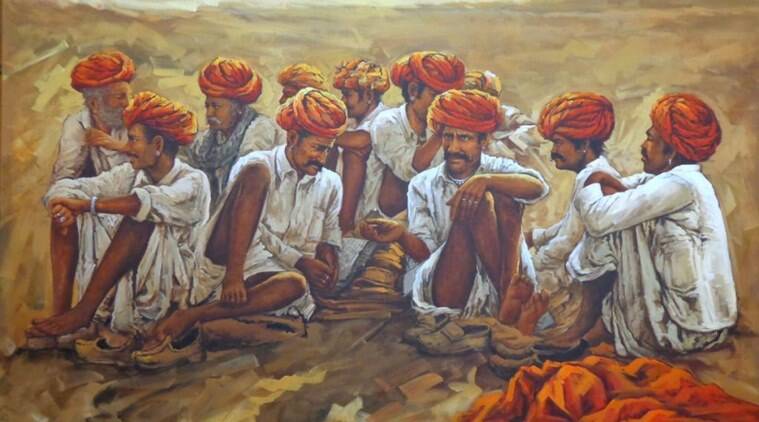
Banjara history which traces back to ancient times to pre-Indus river civilization was buried and not known to the world as there were no written documents.
By Babu Chinna Jamia Nayaka
Types of Marriage
If the girl’s father did not had a male heir or son being incapable of managing the family the betrothed groom would go to father-in law house and serve. In return the boy will be given the girl in marriage and a portion of the property from the father in-law. Thereafter the boy no longer attached himself to his father’s house or property.
Marriage by Exchange
In this marriage both the parties will give and take the bride. In this type of marriage normally dowry is not given, rather brides are exchanged. This is a good practice since it reduces the burden of dowry and over expenditure in marriage.
Marriage by Elopement
The boy and girl who fell in love and whose parents could not agree in marriage usually eloped. After certain period is lapsed they will be brought before the Nasab and Dand (fine) is paid to the girl’s father. They will be allowed to live as husband-wife in the Thanda.
 Widow Remarriage
Widow Remarriage
In Banjara society a widow is allowed to marry either the younger brother of the deceased or any suitable person in the same clan. If no suitable person is available she can marry from other clan, but within the Banjara community. But this kind of marriage is done in a temple
Marriage Symbols
The Banjara marriage was performed by the community priest or the Naik. However due the influence of Hinduism the Hindu Brahman priest performed the marriage in front of the bride’s house. The marriage symbols are upper arm rings (Chuder Baliya), Pendants (Ghogri), and Thali.
Polygamy
Polygamy was allowed but monogamy is a norm but on certain grounds such as childlessness, sick wife, only girl children were born, and any widow of a near relative left without care, then the man was allowed to marry for the second or third time keeping all wives with him. In the recent times this system has diminished among Banjara due to non-availability of women and also risen awareness on health problems. In recent times the awareness on social and health problem, and decline in girl child ratio has caused decline in its practice.
Use of Intoxicants
Liquor, Bhang, hookah, beedi, tobacco, and chewing beetle nut/leaf, have been part and parcel of Banjara life. Without liquor no Banjara programs were held. Banjara women and men brewed the alcohol at their homes and in nearby hills. Because of the use of intoxicants poverty, debts, health problems, bonded labor and illiteracy prevailed among them.
Sorcery, Magic/Charms
Before venturing into any works Banjara people invoked their ancestors for fruitful result in their journey, robbery, work or family and for fortune. They had also used magic, charms, and sorcery for both good and bad purposes. Especially for healing the Banjara witch doctor was highly consulted.
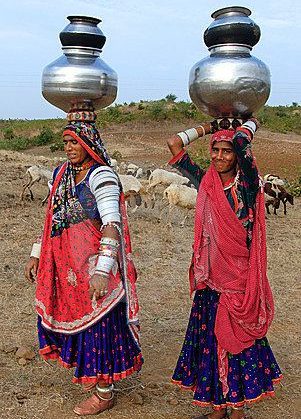 Place of Women
Place of Women
Banjara women were not strictly subordinated to men and at the same time not fully free. Women were allowed to divorce, remarry, and also if unjustly deserted she will be given half the portion of husbands property. Women also involved in agriculture, animal husbandry, collection of firewood, cattle breeding, and they contribute to the income of the family by making liquor. The women can participate in social, religious and political activities but only men have the voice and perform the ritual ceremonies.
The Thanda nasab was male hierarchical and women were not allowed to head the Thanda. The property and succession in the family devolves upon the eldest son. In the modern times due to the influence of outside society, modern education and contact with outside world the role and place of women was changing and women have been given a good place.
Banjara Cultural life and Practices
Banjara people have a unique cultural life and practices that differentiate them from others. The language, food, dress and ornaments, art and dance, body tattooing and ceremonies formed the cultural world of Banjara people. The influx of modern life style and growing contact with non-Banjara world had affected the Banjara cultural life.
Language
The language of Banjara is known as “Gor boli” “Gor mati Boli or “Brinjari,” an independent dialect. The dialect spoken by Banjara/Roma Gypsy falls in the category of Indo-Aryan language. Robert Caldwell writes that “the Lambadis, the gypsies of peninsula, speak a dialect of Hindustani.” The dialect was spoken since the pre-Indus period in Gor provinces of Afghanistan, Baluchistan, Sindh, Punjab, Gujarat, Kethewada, Harappa and Mahenjodaro. Banjaras can easily understand the Hindi and Sanskrit language as about 90% words resembled with ‘Gor boli’. Gor Boli was spoken within the family and kin groups, and the regional/local languages were used to communicate with others.
Food
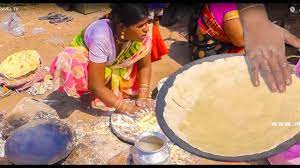
The traditional food of Banjara people were Daliya (mixed cereal), Bati (roti), Saloi (made from goat or sheep or pork blood and intestines), and Ghuggari (boiled cowpea, red gram, land gram etc.) and occasionally rice is used. ‘Patali baati’ was made from quality wheat or bazra or ragi and eat with chicken curry or boiled green leaves. They were found of non-vegetarian food except beef. The Banjara dogs were famous for hunting the wild animals.
Dress
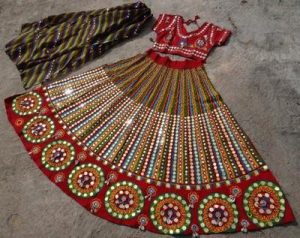 The Banjara women wore a colorful dress with rich embroidery, jewellary and mirror patch works. Their dress include Phetiya (the skirt), kanchali (blouse), Kurta (the top), Chantiya (the veil). The ornaments used were: Baliya (bangles), Kasautiya (armlet), sadak(skirts decorated with draw string), Gagri/topli(clips worn by married women), Pawlar Haar/Haasli(the necklace made of coins), Bhuriya (nose ring), finger rings, Ghoogri-Chotla (metal flowers and balls suspended from the hair), kolda (leg ankle rings), which were different from others. Banjara men wear Dhoti, Kurtha or long shirt and pagadi (turban) with multiple rounds. However, due to the influence of modern developments there is a gradual change taking place in their dress and ornaments of Banjara women.
The Banjara women wore a colorful dress with rich embroidery, jewellary and mirror patch works. Their dress include Phetiya (the skirt), kanchali (blouse), Kurta (the top), Chantiya (the veil). The ornaments used were: Baliya (bangles), Kasautiya (armlet), sadak(skirts decorated with draw string), Gagri/topli(clips worn by married women), Pawlar Haar/Haasli(the necklace made of coins), Bhuriya (nose ring), finger rings, Ghoogri-Chotla (metal flowers and balls suspended from the hair), kolda (leg ankle rings), which were different from others. Banjara men wear Dhoti, Kurtha or long shirt and pagadi (turban) with multiple rounds. However, due to the influence of modern developments there is a gradual change taking place in their dress and ornaments of Banjara women.
Art and Dance
The Banjara women’s best art work is seen on their costumes and dress with rich embroidery. K. S. Singh mentioned that “The art of body tattooing and crafts like embroidery (cloth), carpentry, and balcksmith were practiced by them. Community possessed the oral traditions, folk-tales, and folk-lore in which their history was continued. Folk songs were sung by both men and women. Percussion, bronze plates and cymbals were their musical instruments.” Banjara dance was famous in which both men and women danced to the tune of Drum (nangara) and songs. Due to the impact of modernism many of its cultural identities were slowly lost.
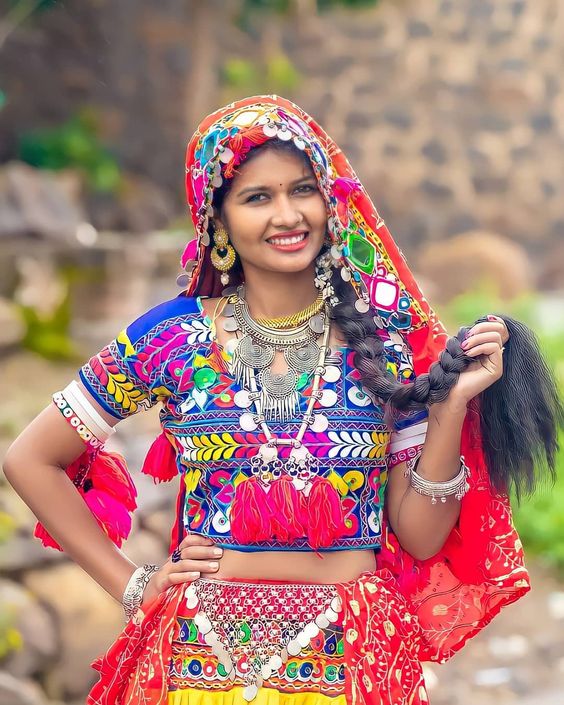
Education among Banjara
The Banjaras were predominantly non-literate as they lived a nomadic life which did not give them the opportunity to learn. Colonel Mackenzie says that “A Banjara who can read and write is unknown. But their memoires, from cultivation, are marvelous and very retentive.” But due to modern education impact there are changes and K. S. Singh points out that “They favor education for boys but are not favorably disposed towards girl’s education. Their children drop out from educational institutions owing to poverty, disinterest and/or other social reasons.”
According to 1981 census Banjara literacy rate in Karnataka was 13.54 of which rate of male literacy 21.54 and 5.02 of female literacy. But in 2001 there is a slight change in its literacy progress in Karnataka standing at 43.0 percent, still lower than any other SC communities.
There were reasons why Banjara did not get education. First, they were nomads, often were on move from place to place. Second, whole family was involved in trade, cattle breeding, and some were in dacoiti. Third, education was only given to a section of people in society, whereas Banjara keep secluded. Fourth, people disliked them and so Banjara people could not mix with other people. And finally, they were not aware of the value of education nor any body bothered about them.
Banjara Literature
Traditionally, Banjaras never kept any written records nor sustained an oral history due to their frequent travels. Banjara dialect does not have script hence the history and tradition of Banjaras are reflected in the form of songs, ritual songs, folklores, stories, myths, proverbs and phrases. Hiralal says that their history and songs were learnt by heart and transmitted orally from generation to generation.
Due to the impact of modern influence on younger generation, much of the oral history and songs were lost and therefore the local script is used to write and preserve the rich traditional history of Banjara.
Economic Life of Banjara Community
Before the establishment of British colonialism in India, the economic life of Banjara had flourished through trade on packed bullocks. During colonial times as the new transport, market and circulation system were developed, free pass was restricted and tax were laid on sale by the Banjara. As a result the economic life of Banjara was put to death. Francis in this regard writes:
“They used to live by pack-bullock trade, and they still remember the names of some of the generals who employed their forebears. When peace and the railways came and did away with these callings, they fell back for a time upon crime as a livelihood, but they have now mostly taken to agriculture and grazing.”
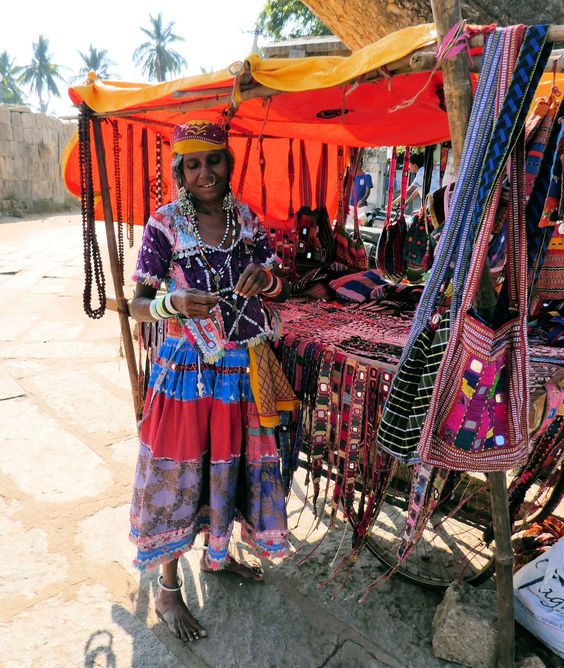 As their business diminished, they resorted to dacoities and cattle stealing. Majority Banjara live under severe poverty and in the modern times a very few hold white collar jobs. Tanaji G Rathod who did a study on socio-economic life of Banjara in Karnataka says that due to illiteracy, alcoholism, crimes, anarchy, exclusion from outside world, rigidity, and ignorance and lack awareness of situations Banjara were still under the severe poverty. The loss of their livelihood led to indulge in various types of crimes and unsocial works. Despite various programs by the governments, NGOs, and self-help groups the economic condition of Banjara remains pathetic.
As their business diminished, they resorted to dacoities and cattle stealing. Majority Banjara live under severe poverty and in the modern times a very few hold white collar jobs. Tanaji G Rathod who did a study on socio-economic life of Banjara in Karnataka says that due to illiteracy, alcoholism, crimes, anarchy, exclusion from outside world, rigidity, and ignorance and lack awareness of situations Banjara were still under the severe poverty. The loss of their livelihood led to indulge in various types of crimes and unsocial works. Despite various programs by the governments, NGOs, and self-help groups the economic condition of Banjara remains pathetic.
The Banjara migrants who have settled in Bagepalli taluk about two centuries ago have not been assimilated into the main stream economic life. Poverty, food insecurity, debts, and economic difficulties prevailed among them. People constantly move to distant places for earning livelihood. As a result during off season and whenever possible migrate to the cities.
Land and Banjara people
A few Banjara owned land, but majority were landless laborers and still live the migratory life. Land gives the identity and autonomy to the people which Banjara does not have. Banjara, the nomads, had never own land, but always on move from one place to another. Banjara people were pushed to the periphery, and were controlled by the local land lords.
Religious Life of the Banjara People
Banjara were animists or nature worshippers. In the Banjara religious world the animal sacrifices, ceremonies, gods, house, ancestors, stories and myths, sin and punishment, and future of death occupy the centre stage. The religious life of Banjara worshipped Nature, Sun, Fire, Water, and the Earth. The festivals, gods, rituals, and beliefs, ceremonies were peculiar to Banjara people. Banjara follow Hinduism but practices in their own way. Iyer writes that “Banjaras resemble other Hindus in their religious faith and worship all the gods of the Hindu Pantheon.” They worship lord Krishna, Bull, Hanuman, lord Venkateshwara, and Shiva besides their tribal gods Tulja Devi, Banashankari, Maramma, and Huliamma, Mittu Bhukiya, Banjari Devi, and Siva Bhiya/Sheval Bhaiya. They also worship cattle. Whole community participates in the religious celebrations, but only men perform the ritual.
Festivals
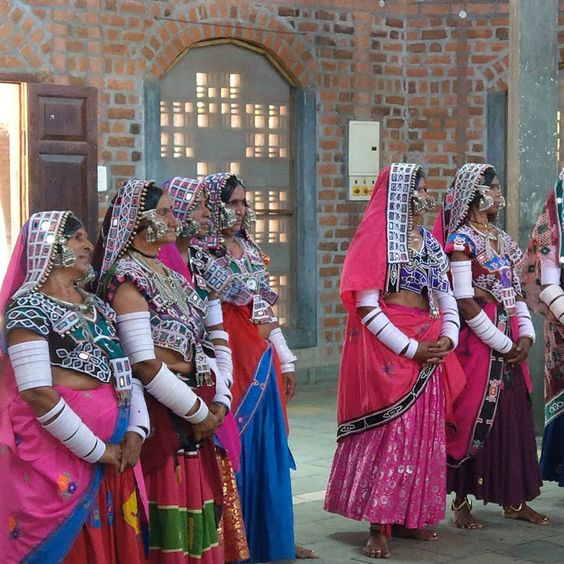
The festivals also distinguished Banjaras from others as festivals brought identity and vigor to the community life. Banjara celebrate the Hindu festivals Dusshera, Diwali, Ugadi, Holi, Ganesh Chathurthi, and in recent times they also celebrate the New Year. During Holi women go around villages, perform kolata (Holi dance) and collect alms for celebrations. On full moon day early morning both men and women gather around the fire to quench their desires. Both men and women will have great fun letting their vent to various propositions. Teej is famous festival of Banjara where both boys and girls come out to enjoy in celebration. Bhog is another important celebration of Banjara during which the new born child’s hair cutting will be held and child was dedicated.
Sacrifices
Banjara were a non-vegetarians and offered sacrifices during marriage, festivals, rituals, journey, and celebrations. On occasions such as sickness, death, and pilgrimages sacrifices was offered. For invoking the blessings of gods and their legendary ancestors Banjara people offered animals and it was an important part of Banjara religious life.
Ancestor Worship
Banjara were animists and worshiped nature viz., sun, moon, water, trees, wind, fire, earth and cow. Banjara have a strong belief in ancestors and during Diwali and Holi festivals, on the day of ‘Pitrupuja’ they mix cooked rice with Jaggary and Ghee (clarified butter), and offer it on fire, it is known as “Dhabkar.” Also sweets, goat curry, and liquor were offered to their ancestors. This ritual is performed by only men, women were not allowed. In the common worship or prayer both men and women participate, normally in the evening. Normally the place of worship will be in the east side of the Thanda and but facing West side they pray with folded hands. Head of the family or Thanda will lead this prayer. Even today this practice was continued among them.
Spirits/Demons
Banjara people believed in magic, sorcery, and spirits for good and bad purposes. For good purpose such as health, successful travel, while going for dacoiti, to find offenders, the Bhagat or janiya, the witch doctor was consulted. For bad purpose such as to harm, bring sickness, and death, breaking the family, and any bad works the dakun(witch) was consulted. There was a belief that the spirit of those who had died due to suicide, poison consumption, and unnatural death and with gross sins will be turned into demons (Bhoot) and troubled people. Since Banjara lived in seclusion and away from outsiders they highly believed in them.
Rituals of Death
According to the Banjara traditional custom the dead persons were buried with their head facing to the North and legs towards the South. Gor people still follow this direction while burying the dead. In Some places Banjara people burn the married person on funeral pyre and unmarried were buried.
The word “Samgo” or “Saat Wego” is used to convey the news of a dead person. Whole Thanda is gathered in front of the bereaved family to express solidarity in their sorrow by part-taking water from a single pot.
On the third day the relatives collect donations and cut a goat to give food to the bereaved family. As a custom the ritual is performed outside the Thanda under a tree where the relatives and Naik prepare rice cake, mix with jiggery and Ghee which is called “Churmo”. After offering the water and Churmo to the dead person the remaining is shared among them. The Churmo is eaten in the same place and not allowed to take home. No other community or people practice such a ritual to a dead person.
Belief of Sin and Salvation
Banjara exactly do not believe in Sin and Salvation but believed that a person’s future is based on his/her works. According to Banjara for an unjust cause if any person does wrong or commits crime is a sin and will go to hell. For a just cause or without knowing if any wrong is done it is pardonable. The unjustly sinned person will be thrown into the “angaarer Khuvema” (well of fire) and is tormented forever.
Banjara believe in life after death or in salvation of the soul. The righteous person will go to Hariyali Bag.” The soul will rest in a place where happiness exists and there is no thirst or hunger, the person will live in eternity. Therefore, they never harm the Mother Nature and before venturing into any works they asked forgiveness for any untoward works done.
Conclusion
Banjara were one of the ancient nomadic tribes of India which possessed a peculiar habitation, history, culture, religious and social practices, festivals, language, folk lore, dress, governing system, and understanding of death, sin and salvation. The Thanda living helped Banjara people to preserve their traditional and cultural practices undefiled from outsiders. At various point of times and due to various reasons Banjaras had migrated to Europe through Asia Minor and Greece. The British colonialism had uprooted them from their nomadic trade, culture and social life by branding them as criminals. Many tribal characteristics, cultural and social practices have under gone tremendous change. Severe poverty among Banjara had forced them to migrate to the cities where they came in contact with modern culture, language, lifestyle, and living system which impacted on their tribal life. At this juncture of transition in early 1970s Christianity entered the Banjara community in Bagepalli. The next chapter has exclusively dealt with the advent of Christianity and its influences among the Banjara people. (Concludes)
____________________
Courtesy: Sinti Roma (Germany)